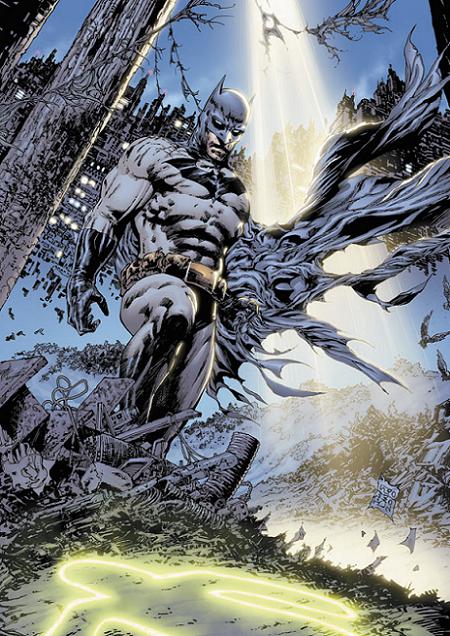Images & Words – Batman #702
[images & words is the comic book pick-of-the-week at OL. equal parts review and diatribe, the post highlights the most memorable/infuriating/entertaining book released that wednesday]
Spoilers Ahead. Forreal.
3. 2. 1. Blast off!
Once I’ve escaped Earth’s gravitational pull, I fire up the hyperdrive. I shoot past the moon, past Neptune, past the limits of our damn solar system. I disengage the primary thrusters and find myself in the middle an interstellar storm. I careen past stray panels and pixilated nuclear explosions and bits of what was once a moon. I could’ve sworn that I had set the proper coordinates. But my eyes are telling me different.
So are my onboard monitors. I watch the Galactic Positioning System power down, turning all of the maps and sequencers and frames of reference into nothing more than an abysmal black screen. A moment later, the GPS reboots. When the screen settles, it tells me that myth has become fact.
[You have reached Omega Level]
///
This week’s comic of choice is Batman #702.
I won’t lie; the decision to feature this book might be yet another testament to my dwindling sanity.
This comic is the second half of a two-story arc entitled R.I.P. — The Missing Chapter. Essentially, the arc gives insight into what happened to Bruce Wayne between Batman R.I.P. and Final Crisis. Which is important, ya know, since for awhile it seemed as though Grant Morrison had killed Caped Crusader twice. Morrison and Tony Daniel work to address some of the complaints that arose and I think they do it well.
Let me pause for a second. If you haven’t read Final Crisis, you’re going to be fugging lost. Hell, I read the miniseries and I’m not 100% sure what’s going on. Still, even a slightly befuddling plot doesn’t prevent me from reveling in some of themes and tropes being explored. Is there something to be said for high-fiving the statues as you flee from a burning museum?
I think so.
Through the kooky tale of Batman killing Darkseid and being shot backwards through time, Morrison explores the notion of narrative structure. Specifically, Batman takes the reader through a journey in which characters and plot devices are identified as being archetypes. In this sense, it becomes clear that the multi-dimensional superheroics still boil down to the bare essentials.
Bruce Wayne recollects his confrontation with Darkseid;
A world where the stakes were ultimate stakes, where each moment was heavy with the massive weight of unfolding myth…
He might have been a wolf once, a dragon or a tyrant.
How many times in human history had this moment played out?
…and everything had a thousand extra layers of meaning.
Like Darkseid.
The monster… and the man standing in his way?
[Batman vs. Darkseid]
[David vs. Goliath]
[Man vs. Monster]
[Hope vs. Tyranny]
It’s an interesting twist, to have the narrator recognizing his struggle as being yet another incarnation. A hyperbolic representation of a time-tested model. But then again, Morrison isn’t afraid to flirt with metafiction (and the metaphysical and metacognition and metameta and meta-gods-know what).
I don’t know where I’m going with this. The fact is that I’ve been doing some thinking lately about superheroes and their role in our world. Today, especially with their presence in blockbuster movies, superheroes are regarded as the popular figures for telling age-old tales. Maybe we’ve had these characters for eons but have to reinvent them from time to time.
Is Superman really that much different from Zeus? The father figure for those who wield incredible physical prowess for good, coming to Earth from another realm? Couldn’t Batman be our modern-day inception of Hades? Ruling in the dark, managing the dead?
I know I’m not breaking new ground.
But then again, neither was Morrison.
And that’s the point. I don’t look at archetypes and say, “Blargh! Who cares, man?! Everything has been done before.” I look at them and say, “Hey, that’s a solid skeleton. Let’s see how much muscle and tissue and skin and hair we can toss on that motherfugger. Hell, then we can dress it up like a gay mailman.” Even if there are inescapable structures in place (which is still up for debate), that doesn’t mean that the ensuing construction has to be limited.
Sometimes, a story is just about a kid with a slingshot taking out a damn giant. Other times, the same story is a man dressed as a rodent shooting an oppressive God with a time-bullet.
I’ll take the rat-guy and his time bullet.




